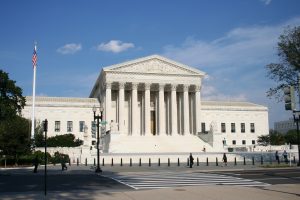
Three more decisions were handed down by the Supreme Court this morning. All the decisions were 5-4, which continues to signify the ongoing swingy-ness of Justice Anthony Kennedy. With the mostly even split of liberals and conservatives on the court (Chief Justice Roberts’ two rulings on Obamacare being noted here), Emperor Kennedy is enjoying his role as lawgiver and kingmaker.
In Michigan v. EPA, the court ruled 5-4 against the EPA’s rules on limiting pollutants coming from power plants.
The rules began to take effect in April, but the court split 5-4 along ideological lines to rule that the Environmental Protection Agency failed to take their cost into account when the agency first decided to regulate the toxic emissions from coal- and oil-fired plants.
The EPA did factor in costs at a later stage when it wrote standards that are expected to reduce the toxic emissions by 90 percent. They were supposed to be fully in place next year. The issue was whether health risks are the only consideration under the Clean Air Act.
The challenge was brought by industry groups and 21 Republican-led states.
Writing for the court, Justice Antonin Scalia said it is not appropriate to impose billions of dollars of economic costs in return for a few dollars in health or environmental benefits.
The case now goes back to lower courts for the EPA to decide how to account for costs.
In Glossip v. Gross, the court again ruled 5-4 that the use of the drug midazolam does not violate the Eighth Amendment’s “cruel and unusual punishment” clause.
The drug was used in executions in Arizona, Ohio and Oklahoma in 2014 that took longer than usual and raised concerns that it did not perform its intended task of putting inmates into a coma-like sleep.
Justice Samuel Alito said for a conservative majority that arguments the drug could not be used effectively as a sedative in executions is speculative.
In dissent, Justice Sonia Sotomayor said, “Under the court’s new rule, it would not matter whether the state intended to use midazolam, or instead to have petitioners drawn and quartered, slowly tortured to death, or actually burned at the stake.”
Alito responded, saying “the dissent’s resort to this outlandish rhetoric reveals the weakness of its legal arguments.”
However, Justices Breyer and Ginsburg, in their separate dissent, suggested that the death penalty itself may be unconstitutional. This debate will obviously continue to go on for years to come.
And in the last case, Arizona State Legislature v. Arizona Independent Redistricting Commission, Kennedy swung the other way to join with the liberal justices.
The Arizona case stemmed from voter approval of an independent commission in 2000. The legislature’s Republican leaders filed their lawsuit after the commission’s U.S. House map in 2012 produced four safe districts for Republicans, two for Democrats and made the other three seats competitive. Democrats won them all in 2012, but the Republicans recaptured one last year.
Justice Ruth Bader Ginsburg wrote for the court that there is “no constitutional barrier to a state’s empowerment of its people by embracing that form of lawmaking.”
“Arizona voters sought to restore the core principle that the voters should choose their representatives, not the other way around,” Ginsburg said.
Justice Anthony Kennedy and Ginsburg’s three liberal colleagues joined her opinion.
In dissent, Chief Justice John Roberts accused the majority of approving a “deliberate constitutional evasion.”
“The court’s position has no basis in the text, structure, or history of the Constitution, and it contradicts precedents from both Congress and this court,” Roberts said. Justices Samuel Alito, Antonin Scalia and Clarence Thomas signed onto Roberts’ opinion.
Anthony Kennedy clearly likes being in the majority. And the time of the Supreme Court being an impartial branch of government has now formally passed into history. It is, as Andrew McCarthy of National Review wrote, a political branch, and we need to acknowledge that.
Here’s an idea for the EPA. Take 30 steps back from their regulation spree and really take a look at how the newer power plant technology does in fact limit pollutants instead of reinventing and making a newer costlier unworkable wheel.
1 Comment